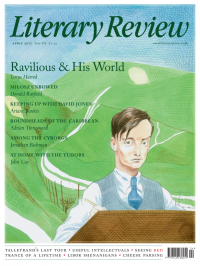Tim Richardson
Whither the Snow House?
Gardens of Court and Country: English Design 1630–1730
By David Jacques
Yale University Press 406pp £45
Today, Wanstead Park consists of 140 acres of pleasingly rough grassland and woods in the east London borough of Redbridge, a public amenity with a golf course and open-air theatre productions in summer. It borders Epping Forest and has a slightly wild air. The last time I visited was with a Welsh terrier club, when about thirty identical black-and-tan canines went charging about in the long grass and then dived into a stream. Our rendezvous point was the visitor centre known as the Temple, one of the few visible remnants of an 18th-century formal landscape made to complement the long-vanished Wanstead House, a vast and architecturally pioneering Palladian mansion. The grand original garden, completed in 1722, was the final work of the designer and nurseryman George London. Engravings of the plans for Wanstead House and its sumptuous garden were published as the highlight of Vitruvius Britannicus (1715), the most important book of architectural perspectives of the period. The finished garden did not disappoint and for a while Wanstead even outshone more established estates such as Chatsworth, Longleat and Badminton.
But its fame did not last. The estate went into decline and the house was demolished in 1825. All that is left of the 18th-century house and landscape today is the Temple, a ruined grotto and a lake that was formerly a large octagonal pool. It is still

Sign Up to our newsletter
Receive free articles, highlights from the archive, news, details of prizes, and much more.@Lit_Review
Follow Literary Review on Twitter
Twitter Feed
It wasn’t until 1825 that Pepys’s diary became available for the first time. How it was eventually decrypted and published is a story of subterfuge and duplicity.
Kate Loveman tells the tale.
Kate Loveman - Publishing Pepys
Kate Loveman: Publishing Pepys
literaryreview.co.uk
Arthur Christopher Benson was a pillar of the Edwardian establishment. He was supremely well connected. As his newly published diaries reveal, he was also riotously indiscreet.
Piers Brendon compares Benson’s journals to others from the 20th century.
Piers Brendon - Land of Dopes & Tories
Piers Brendon: Land of Dopes & Tories - The Benson Diaries: Selections from the Diary of Arthur Christopher Benson by Eamon Duffy & Ronald Hyam (edd)
literaryreview.co.uk
Of the siblings Gwen and Augustus John, it is Augustus who has commanded most attention from collectors and connoisseurs.
Was he really the finer artist, asks Tanya Harrod, or is it time Gwen emerged from her brother’s shadow?
Tanya Harrod - Cut from the Same Canvas
Tanya Harrod: Cut from the Same Canvas - Artists, Siblings, Visionaries: The Lives and Loves of Gwen and Augustus John by Judith Mackrell
literaryreview.co.uk